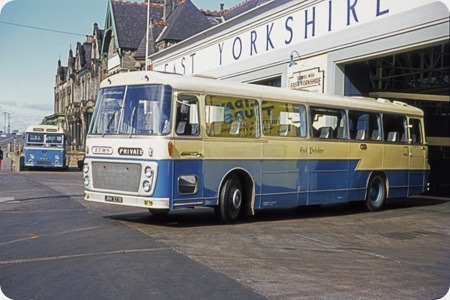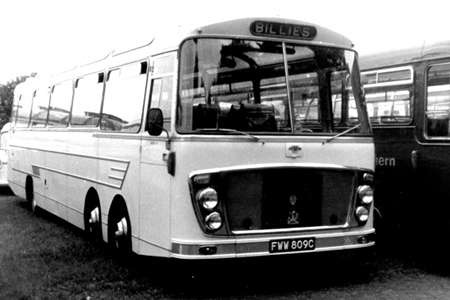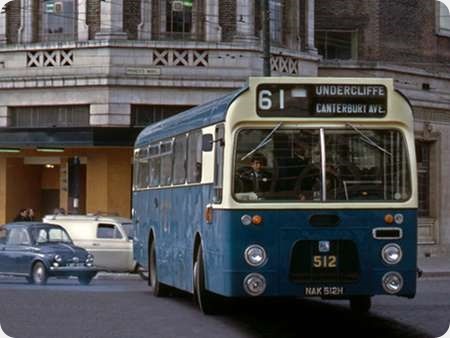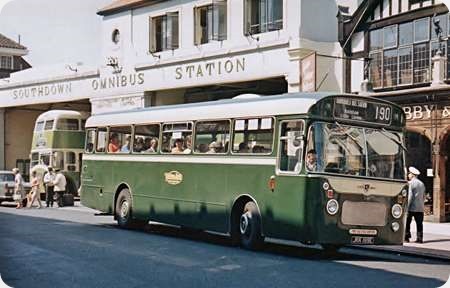East Yorkshire – Leyland Panther – JRH 323E – 823
East Yorkshire
1967
Leyland Panther PSUR1/2R
Weymann Topaz II
The Panther and Panther Cub were Leyland Motors’ rear underfloor-engined offerings during the mid- to late-1960’s. By this time AEC had been taken over and its Swift model shared the same chassis as the Panther, each using their own engines (O600/O680 and AH505/691 respectively), the Panther having a front mounted radiator, whilst the Swift’s was at the rear. Both bus (with a stepped chassis frame) and coach (with a high, straight frame) were offered, the Swift also being offered with a constant-mesh gearbox in place of the more usual semi-automatic. The shorter Panther Cub – originally introduced to meet the requirements of Manchester CT – had a shorter rear overhang and of necessity had to feature the smaller O400 engine. An equivalent shorter Swift was offered with the AH505 engine only.
Several operators – both municipal and company, and some overseas – bought the Panther and Panther Cub in their bus form, and operated them with varying degrees of success, many having relatively short lives mainly due to bodywork deficiencies. The coach version was relatively uncommon though, the largest operator probably being Seamark’s of Bedfordshire, along with Skill’s of Nottingham.
East Yorkshire took 24 Panthers and 17 Panther Cubs. The Panthers consisted 15 buses, 4 DP’s and 5 coaches – but all based on the PSUR1/2R coach chassis. The second batch of three coaches had Plaxton Panorama bodies, but the first pair (823/824) had very rare Weymann Topaz II C44F coachwork.
Here 823 is seen emerging from the company’s Anlaby Road, Hull premises in 1972.The pair were repainted into the NBC corporate white livery in 1973, but were to pass to the NBC’s vehicle cannibalisation centre at Bracebridge Heath, near Lincoln in 1976 to be stripped for spares, after which the remains were sold to Pickersgill & Laverick, the Carlton breakers.
Photograph and Copy contributed by John Stringer
29/11/17 – 08:24
A Willowbrook DP-bodied PSU3 of 1962 also in view.
Mark Evans
30/11/17 – 08:14
Not a bad looking coach but a bit let down by the rather oversized front grille.
Philip Halstead
01/12/17 – 06:53
Good point, Philip. One expects something better from Weymann.This is a touch vulgar.
David Wragg
02/12/17 – 07:30
I think it’s unlikely that the Topaz II was designed by Weymann, and even more unlikely that it was built by them, since the factory had been closed for 18 months by the time it was delivered. Blame MCW.
Peter Williamson
02/12/17 – 07:31
Can you see that the outline of the grille is basically Duple 1963-1965 (Bella Vega/Vega Major)? By this time, of course, Weymann no longer existed. It is strictly speaking a MCW body.
David Oldfield
13/12/17 – 08:00
Maybe a bit of a BET Group thread here; EYMS with Panther buses and a few coaches, similar to PMT with Roadliners. I wonder how reliable the Panthers were? Would they be used on extended tours? The zig zag flash on the body side forward of the rear wheel arch looks strange and as already commented the front is rather bland with its unappealing grille.
Ian Wild
13/12/17 – 09:48
I took a photo of another coach in Ilfracombe whilst on holiday in 1969 and there is one of these Panthers parked up in the background, so it seems likely they were used on extended tours. I’m very surprised now that I didn’t photograph the Panther also. //www.sct61.org.uk/zzrdf880g
John Stringer
15/12/17 – 07:24
The entire design looks rather untidy to my eye. Not just the bizarre zig zag on the side and the "parts bins" frontal appearance, but also the fractionally deeper first side window, all conspire to give an insipid, rather than an ugly effect. Wasn’t the original Topaz of circa 1962 redesigned around 1965, which would make the example above a very rare Topaz II?
Roger Cox
15/12/17 – 11:03
About 6 on Bedford VAL14, I believe, and the East Yorkshire Panthers. That was it.
David Oldfield
16/12/17 – 09:20
I have to confess to liking this design: it is all the things the 50’s juke box styles were not- simple, easy on the eye- very 60’s, perhaps Farina. Shortcomings in appearance are surely down to an unsympathetic livery: the white roof dropped down the front, giving too much emphasis to the darker grille- no attempt to use a colour or shade that would draw the necessary elements- lights, vents, displays- together: imagine the dark East Yorks blue overall here and generally replacing the insipid lighter blue : similarly the windows, where the smaller front group would provide the point at which the flash could (if anywhere) begin.
I now digress: purely on livery, has anyone seen a Borismaster in adverlivery? Window dividers on examples I have seen are not then camouflaged to give the impression of a single glazed area, and one I saw had white dividers: the result just emphasises the bizarre design.
Joe
17/12/17 – 07:22
I must point out that the ‘white roof dropped down at the front’ actually, erm…doesn’t. The original slide was a bit on the pale overexposed side and in editing the scan I boosted the colour saturation but it couldn’t bring out the primrose at the front without overdoing the rest of it. In fact I don’t think the roof was white either! I normally wouldn’t submit such a print but it just seemed a bit of a rarity and there wasn’t one on the site.
John Stringer
17/12/17 – 09:19
This Bedford VAL was parked at Gosforth Park races sometime in the late 1960s, my only ever sighting of a Weymann Topaz body.
Richard Slater
17/12/17 – 10:22
This was operated by Billies coaches of Mexborough, The previous VAL purchased having been a much more traditional Duple bodied item meant this one seemed quite exotic at the time. I assume being a bit of an oddball just meant that they got it for an attractive price.
Andrew Charles
22/12/17 – 07:04
I feel that this coach has a stylish charm of its own. In my humble opinion, the chief problem is that the zigzag flash at the back goes DOWN. If the flash went UP at the same point, it would give a ‘Get up and Go’ impression, rather than its unfortunate ‘Down at Heel’ look.
But I do accept that these things are subjective and our personal tastes will all differ.
Petras409
23/12/17 – 07:57
Interesting to look at other EYMS bus liveries using the dark blue- under EY on this site. Dark blue worked well for the late lamented GNER trains too.
Joe
23/12/17 – 07:58
Petras409, I can’t help but agree with you that the overall design did have a charm of its own, let down by the zigzag flash. A simple straight moulding front to rear would have improved things I feel, especially if positioned to ‘kiss’ the top of each wheelarch. Alternatively, the ‘new’ horizontal moulding could have been stepped down to subtly match the window line at the first bay. In either case the moulding could then have terminated at the centre line of the upper headlamp, which would have made more of a feature of the radiator grille.
With respect to Joe’s comment re the livery, East Yorkshire’s coaches looked splendid in primrose and blue and were always very smartly turned out. Use of the dark blue, primrose and white livery on 823/4 would have meant that they had been demoted for bus work, although it has to be admitted they would still probably have looked just as smart. Now is my memory playing tricks, or am I right in thinking that for some reason the Topaz-bodied Panthers did not carry the usual EYMS ‘xxxxxx Star’ names on their sides?
Brendan Smith
03/04/18 – 07:00
I remember the Topaz bodied Bedford VAL FWW 609C of Billies Coaches very well & in later years it passed to Howards Coaches of Whitby who named it "Concorde". Even though the VAL has always been one of my favourite types of PSV,the driver would have his work cut out winding one up to 65 MPH on the motorway so they were not Supersonic in any way!.
Andrew Spriggs
05/05/18 – 06:43
Weymann did all the Topaz II bodies on VAL14. The two on Panther were built by MCW.
Stephen Allcroft
07/05/18 – 07:11
Phillip and David W – I couldn’t have described the radiator grille any better – "a touch vulgar" indeed.
Chris Youhill
Quick links to the - Comments Page - Contact Page - Home Page





